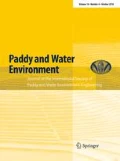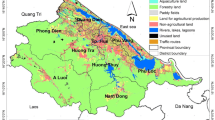Abstract
We characterized 63 fields sampled based on farmers’ perception of production risks within each commune (referred as either safe or at-risk fields), from the 3 communes in the 2 contrasting estuaries with different farming transformation in Red River Delta, Vietnam (Giao Huong and Giao Thien communes in Ba Lat estuary, Nam Dien communes in Day estuary), for 6 cropping seasons from 2015 to 2017. Rice yield was lower in Nam Dien (472 g/m2) than in Giao Huong (619 g/m2) and Giao Thien (662 g/m2), because of higher salinity levels in Day estuary than in Ba Lat estuary (8.0 ± 4.7 vs 2.9 ± 5.5‰), which led to higher salinity in standing water in the paddies (1.1 ± 0.3 vs 0.8 ± 0.3‰ in spring rice, 0.6 ± 0.3 vs 0.2 ± 0.2‰ in summer rice), and higher [Na+] in the surface soil (2.13 vs 1.7 meq/100 g). At-risk fields had higher water salinity and soil Na+, higher sand proportion, deeper standing water and lower yield than safe fields (558 vs 649 g/m2). Short duration inbred variety was most sensitive to increasing salinity, and farmers planted more hybrid varieties at at-risk fields in spring. Tall local glutinous cultivars with lower yield potential were planted at at-risk fields in summer with less N fertilizer. N fertilizer application rate was high (ca. 200 kg/ha/season) with low use efficiency. This study highlighted small-scale environmental variation and adaptation and yield reduction due to salinity in the two contrasting estuaries in the Red River Delta.









Similar content being viewed by others
References
Aizawa M, Can ND, Van Hao N, Kurokura H, Kobayashi K (2009) Changes in rice farmers’ agronomic practices in response to changes in hydrological conditions for salinity prevention in the Mekong Delta, Vietnam. Trop Agric Dev 53:33–42. https://doi.org/10.11248/jsta.53.33
Ca VT, Vongvisessomjai S, Asaeda T (1994) Study on salinity intrusion in the Red River Delta. Environ Syst Res 22:213–218
DARD of Hai Phong (2016) Hai Phong annual report of 2016 (in Vietnamese). Hai Phong Province
DARD of Nam Dinh (2018) Nam Dinh annual report of 2018 (in Vietnamese). Nam Dinh Province
DARD of Thai Binh (2015) Thai Binh annual report of 2015 (in Vietnamese). Thai Binh Province
Dinh HT, Haruyama S (2006) The main ion concentrations in surface soil layer in Nam Dinh Province of the Red River Delta, Northern Vietnam. Geogr Rev Jpn 79:725–737
Duc NH, Umeyama M (2011) Saline intrusion due to the accelerative sea level in the Red River system in Vietnam. In: ASCE conference proceeding, Palm Spring, USA, pp 4413–4422
General Statistic Office of Vietnam (2018) Statistical yearbook of Vietnam 2017. Statistical Publishing House, Cambridge
Grattan SR, Zeng L, Shannon MC, Roberts SR (2002) Rice is more sensitive to salinity than previously thought. Calif Agric 56:189–198. https://doi.org/10.3733/ca.v056n06p189
Guo Y, Huang J, Shi Z, Li H (2015) Mapping spatial variability of soil salinity in a coastal paddy field based on electromagnetic sensors. PLoS ONE 10(5):e0127996. https://doi.org/10.1371/journal.pone.0127996
Hanh PTT, Furukawa M (2007) Impact of sea level rise on coastal zone of Vietnam. Bull Coll Sci Univ Ryukyus 84:45–59
Haque SA (2006) Salinity problems and crop production in coastal regions of Bangladesh. Pak J Bot 38:1359–1365
Haruyama S, Dinh HT, Le VT (2006) Problem soils of the paddy fields in the eastern coastal plain of the Red River Delta, Vietnam. J Geogr 115:737–749
Hien LT, Quy PN, Viet NT (2010) Assessment of salinity intrusion in the red river under the effect of climate change. J Civ Eng Archit 4:21–26
Homma K, Horie T, Shiraiwa T, Supapoj N, Matsumoto N, Kabaki N (2003) Toposequential variation in soil fertility and rice productivity of rainfed lowland paddy fields in mini-watershed (Nong) in Northeast Thailand. Plant Prod Sci 6:147–153. https://doi.org/10.1626/pps.6.147
Husson O, Verburg PH, Phung MT, Mensvoort MEFV (2000) Spatial variability of acid sulphate soils in the Plain of Reeds, Mekong delta, Vietnam. Geoderma 97:1–19. https://doi.org/10.1016/S0016-7061(00)00016-1
Kamoshita A, Nguyen YTB, Dinh VTH (2018) Preliminary assessment of rice production in coastal part of Red River Delta surrounding Xuan Thuy National Park, Vietnam, for improving resilience. In: Takeuchi K, Saito O, Matsuda H, Mohan G (eds) Resilient Asia. Science for sustainable societies. Springer, Tokyo, pp 7–38
Khai HV, Dang NH, Yabe M (2018) Impact of salinity intrusion on rice productivity in the Vietnamese Mekong Delta. J Fac Agric Kyushu Univ 63:143–148
Kotera A, Nawata E, Thao L, Vuong N, Sakuratani T (2005) Effect of submergence on rice yield in the Red River Delta, Vietnam. Jpn J Trop Agric 49:197–206
Kotera A, Sakamoto T, Nguyen DK, Yokozawa M (2008) Regional consequences of seawater intrusion on rice productivity and land use in coastal area of the Mekong River Delta. JARQ 42:267–274
Kuyek D, Biothai, GRAIN, KMP, MASIPAG, Zamora OB, PAN Indonesia, Philippine Greens and UBINIG, Quijano R (2000) Hybrid rice in Asia: an unfolding threat, pp 1–20. https://www.grain.org/article/entries/34-hybrid-rice-in-asia-an-unfolding-threat. Accessed 25 Dec 2019
Lan TD (2009) Coastal aquaculture and shrimp farming in North Vietnam and environmental cost estimation. Aquat Ecosyst Health Manag 12:235–242. https://doi.org/10.1080/14634980903146791
MONRE (2009) Viet Nam assessment report on climate change. Institute of Strategy and Policy on natural resources and environment Viet Nam (ISPONRE), United Nations Environment Programme (UNEP), Hanoi, pp 1–57
Nam Dinh Statistics Office (2016) Statistical yearbook of Nam Dinh 2015. Statistical Publishing House, Cambridge
Nguyen L, Watanabe T, Funakawa S (2014) Spatiotemporal variability in soil salinity and its effects on rice (Oryza sativa L.) production in the north central coastal region of Vietnam. Soil Sci Plant Nutr 60:874–885
Nguyen YTB, Kamoshita A, Dinh VTH, Matsuda H, Kurokura H (2017) Salinity intrusion and rice production in Red River Delta under changing climate conditions. Paddy Water Environ 15:37–48
Nguyen MT, Renaud FG, Sebesvari Z (2019) Drivers of change and adaptation pathways of agricultural systems facing increased salinity intrusion in coastal areas of the Mekong and Red River deltas in Vietnam. Environ Sci Policy 92:331–348
Nhan DK, Phap VA, Phuc TH, Trung NH (2012) Rice production response and technological measures to adapt to salinity intrusion in the coastal Mekong delta. Technical report of Mekong Future Project. CTU-CSIRO. Mekong Program on Water, Environment and Resilience, pp 1–14. https://www.researchgate.net/publication/235726406_Rice_production_response_and_technological_measures_to_adapt_to_salinity_intrusion_in_the_coastal_Mekong_delta Accessed 26 Dec 2019
Nhuong TV, Le TL, Tu TQ, Tam PM, Nguyet TA (2002) Vietnam shrimp farming review. In: Individual report for the project: policy research for sustainable shrimp farming in Asia. European Commission INCO-DEV Project PORESSFA No.IC4-2001-10042, CEMARE University of Portsmouth UK and RIA1, Bac Ninh, Vietnam
Paul BG, Vogl CR (2011) Impacts of shrimp farming in Bangladesh: challenges and alternatives. Ocean Coast Manag 54:201–211
Phan VQC, Fujimoto A (2012) Land tenure and tenancy conditions in relation to rice production in three villages in the Red River Delta, Vietnam. J ISSAAS 18(1):31–48
Rana RB, Garforth CJ, Sthapit BR (2009) Farmers’ management of rice varietal diversity in the mid-hills of Nepal: implications for on-farm conservation and crop improvement. Plant Genet Resour 7:50–62
Renaud FG, Le TTH, Lindener C, Guong VT, Sebesvari Z (2015) Resilience and shifts in agro-ecosystems facing increasing sea-level rise and salinity intrusion in Ben Tre Province, Mekong Delta. Clim Change 133:69–84. https://doi.org/10.1007/s10584-014-1113-4
Rhoades JD (1982) Soluble salts. In: Page AL, Miller RH, Keeney DR (eds) Methods of soil analysis. Part 2. Chemical and microbiological properties. American Society of Agronomy, Soil Science Society of America, Madison, WI, pp 167–179
Sakamoto T, Van Phung C, Kotera A, Nguyen KD, Yokozawa M (2009) Analysis of rapid expansion of inland aquaculture and triple rice-cropping areas in a coastal area of the Vietnamese Mekong Delta using MODIS time-series imagery. Landsc Urban Plan 92:34–46. https://doi.org/10.1016/J.LANDURBPLAN.2009.02.002
Schollenberger CJ, Dreibelbis FR (1930) Analytical methods in base exchange investigations on soils. Soil Sci 30:161–174
Seetisarn M, Phuong N, Phe PV, Tan LD, Binh PH (1993) Productivity and stability of crops. In: Cuc LT, Rambo AT (eds) Too many people, too little land: the human ecology of a wet rice-growing village in the Red River Delta of Vietnam. East-West Center, Honolulu, pp 104–116
Tanaka A, Saito K, Azoma K, Kobayashi K (2013) Factors affecting variation in farm yields of irrigated lowland rice in southern-central Benin. Eur J Agron 44:46–53. https://doi.org/10.1016/J.EJA.2012.08.002
Thanh TD, Saito Y, Van HD, Nguyen VL, Ta TKO, Tateishi M (2004) Regimes of human and climate impacts on coastal changes in Vietnam. Reg Environ Change 4:49–62. https://doi.org/10.1007/s10113-003-0062-7
Tho N, Vromant N, Hung NT, Hens L (2008) Soil salinity and sodicity in a shrimp farming coastal area of the Mekong Delta, Vietnam. Environ Geol 54:1739–1746. https://doi.org/10.1007/s00254-007-0951-z
Tuan DT, Dung LTC (1999) Agrarian systems and future scenarios for the Red River Delta. In: Kinh NN, Teng PS, Hoanh CT, Castella JC (eds) Towards an ecoregional approach for natural resource management in the Red River Basin of Vietnam. Agricultural Publishing House, Hanoi, pp 243–254
Tuan LA, Hoanh CT, Miller F, Sinh BT (2007) Flood and salinity management in the Mekong Delta, Vietnam. In: Be TT, Sinh BT, Miller F (eds) Challenges to sustainable development in the Mekong Delta: regional and national policy issues and research needs. Sustainable Mekong Research Network, Bangkok, pp 15–68
Tuong TP, Kam SP, Hoanh CT, Dung LC, Khiem NT, Barr J, Ben DC (2003) Impact of seawater intrusion control on the environment, land use and household incomes in a coastal area. Paddy Water Environ 1:65–73. https://doi.org/10.1007/s10333-003-0015-2
Vien TD, Nga NTD (2009) Economic impact of hybrid rice in Vietnam: an initial assessment. In: Yoshimura A (ed) Hybrid rice and transformation of farming systems. Hanoi University of Agriculture, Vietnam, pp 19–35
Wassmann R, Hien NX, Hoanh CT, Tuong TP (2004) Sea level rise affecting the Vietnamese Mekong Delta: water elevation in the flood season and implications for rice production. Clim Change 66:89–107. https://doi.org/10.1023/B:CLIM.0000043144.69736.b7
Acknowledgements
We thank Dr. Nguyen Yen, Vietnam National University of Agriculture, for the selection of the survey site. This study was supported in part by a Grant in-Aid for Scientific Research (No. 16H05780) from the Ministry of Education, Culture, Sports, Science and Technology, Japan.
Author information
Authors and Affiliations
Corresponding author
Rights and permissions
About this article
Cite this article
Phan, L.T.H., Kamoshita, A. Salinity intrusion reduces grain yield in coastal paddy fields: case study in two estuaries in the Red River Delta, Vietnam. Paddy Water Environ 18, 399–416 (2020). https://doi.org/10.1007/s10333-020-00790-y
Received:
Revised:
Accepted:
Published:
Issue Date:
DOI: https://doi.org/10.1007/s10333-020-00790-y




